Nissan ALTIMA 2023 Hazard warning flasher switch and Jump starting
A vital safety feature of the 2023 Nissan Altima is the Hazard Flasher Switch, which gives drivers a rapid and effective way to turn on the hazard lights in an emergency. This switch, which is easily accessible and mounted on the dashboard or steering column, enables drivers to quickly indicate their presence or notify others of a breakdown or roadside emergency. Although its primary purpose is to turn on the warning lights, it also functions as a vital tool for improving visibility and safety, demonstrating Altima’s dedication to providing drivers with the ability to safely communicate with other road users in unexpected or dangerous situations.
2023 Nissan Altima Specs, Price, Features and Mileage (Brochure)
Hazard warning flasher switch
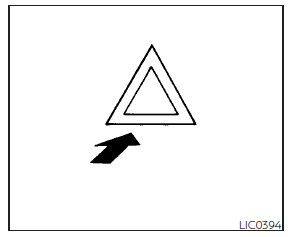
Push the switch on to warn other drivers when you must stop or park under emergency conditions. All turn signal lights flash.
WARNING
- If stopping for an emergency, be sure to move the vehicle well off the road.
- Do not use the hazard warning flashers while moving on the highway unless unusual circumstances force you to drive so slowly that your vehicle might become a hazard to other traffic.
- Turn signals do not work when the hazard warning flasher lights are on.
The flashers will operate with the ignition switch placed in any position.
Some jurisdictions may prohibit the use of the hazard warning flasher switch while driving.
EMERGENCY ENGINE SHUT OFF
To shut off the engine in an emergency situation while driving, perform the following procedure:
- Rapidly push the push-button ignition switch three consecutive times in less than 1.5 seconds, or
- Push and hold the push-button ignition switch for more than 2 seconds.
FLAT TIRE
TIRE PRESSURE MONITORING SYSTEM (TPMS)
This vehicle is equipped with the Tire Pressure Monitoring System (TPMS). It monitors the tire pressure of all tires except the spare. When the low tire pressure warning light is lit, and the “Tire Pressure Low – Add Air” warning appears in the vehicle information display, one or more of your tires is significantly under-inflated. If equipped, the system also displays the pressure of all tires (except the spare tire) on the display screen by sending a signal from a sensor that is installed in each wheel. If the vehicle is being driven with low tire pressure, the TPMS will activate and warn you of it by the low tire pressure warning light. This system will activate only when the vehicle is driven at speeds above 16 mph (25 km/h). and “Tire Pressure Monitoring System (TPMS)”.
WARNING
- Radio waves could adversely affect electric medical equipment. Those who use a pacemaker should contact the electric medical equipment manufacturer for the possible influences before use.
- If the low tire pressure warning light illuminates while driving, avoid sudden steering maneuvers or abrupt braking, reduce vehicle speed, pull off the road to a safe location and stop the vehicle as soon as possible. Driving with under-inflated tires may permanently damage the tires and increase the likelihood of tire failure. Serious vehicle damage could occur and may lead to an accident and could result in serious personal injury. Check the tire pressure for all four tires. Adjust the tire pressure to the recommended COLD tire pressure shown on the Tire and Loading Information label to turn the low tire pressure warning light OFF. If the light still illuminates while driving after adjusting the tire pressure, a tire may be flat or the TPMS may be malfunctioning. If you have a flat tire, replace it with a spare tire as soon as possible. If no tire is flat and all tires are properly inflated, have the vehicle checked. It is recommended that you visit a NISSAN dealer for this service.
- When using a wheel without the TPMS such as the spare tire, the TPMS will not function and the low tire pressure warning light will flash for approximately one minute. Have your tires replaced and/or TPMS system reset as soon as possible. It is recommended that you visit a NISSAN dealer for these services.
- Replacing tires with those not originally specified by NISSAN could affect the proper operation of the TPMS.
- The Genuine NISSAN Emergency Tire Repair Sealant or equivalent can be used for temporarily repairing a tire. Do not inject any other tire liquid or aerosol tire sealant into the tires, as this may cause a malfunction of tire pressure sensors.
CHANGING A FLAT TIRE
If you have a flat tire, follow the instructions below:
Stopping the vehicle
- Safely move the vehicle off the road and away from traffic.
- Turn on the hazard warning flashers.
- Park on a level surface and apply the parking brake. Move the shift lever to P (Park).
- Turn off the engine.
- Raise the hood to warn other traffic and to signal professional road assistance personnel that you need assistance.
- Have all passengers get out of the vehicle and stand in a safe place, away from traffic and clear of the vehicle.
WARNING
- Make sure the parking brake is securely applied and the Continuously Variable Transmission (CVT) is shifted into P (Park).
- Never change tires when the vehicle is on a slope, ice or slippery areas. This is hazardous.
- Never change tires if oncoming traffic is close to your vehicle. Wait for professional road assistance.
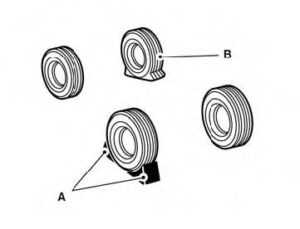
A. Blocks
B. Flat tire
Blocking wheels
Place suitable blocks at both the front and back of the wheel diagonally opposite the flat tire to prevent the vehicle from moving when it is jacked up.
WARNING
Be sure to block the wheel as the vehicle may move and result in personal injury.
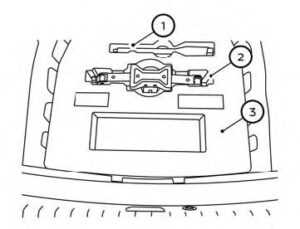
Getting the spare tire and tools
Open the trunk. Lift the luggage floor. Remove the wheel nut wrench 1O and the
jack 2O from the storage cover 3O. Then remove the tool storage cover 3O to access the spare tire.

Turn the clamp to remove the spare tire. Remove the spare tire.
For AWD vehicles – the TEMPORARY USE ONLY spare tire must be installed to the rear wheels only. If a front tire is punctured, install the original rear tire onto the front wheel, then install the TEMPORARY USE ONLY spare tire on the rear.

Removing wheel cover (if so equipped)
CAUTION
Do not use your hands to pry off wheel caps or wheel covers. Doing so could result in personal injury.
To remove the wheel cover, use the jack rod 1O as illustrated.
Apply cloth 2O between the wheel and jack rod to prevent damaging the wheel and wheel cover.
Use caution not to scratch the wheel cover or wheel surface.

Jack-up point
Jacking up vehicle and removing the damaged tire (2WD models)
WARNING
- Never get under the vehicle while it is supported only by the jack. If it is necessary to work under the vehicle, support it with safety stands.
- Use only the jack provided with your vehicle to lift the vehicle. Do not use the jack provided with your vehicle on other vehicles. The jack is designed for lifting only your vehicle during a tire change.
- Use the correct jack-up points. Never use any other part of the vehicle for jack support.
- Never jack up the vehicle more than necessary.
- Never use blocks on or under the jack.
- Do not start or run the engine while the vehicle is on the jack. It may cause the vehicle to move. This is especially true for vehicles with limited slip differentials.
- Do not allow passengers to stay in the vehicle while it is on the jack.
- Never run the engine with a wheel(s) off the ground. It may cause the vehicle to move.
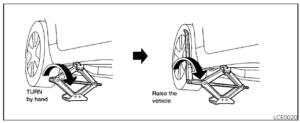
Always refer to the illustration for the correct placement and jack-up points for your specific vehicle model and jack type.
Carefully read the caution label attached to the jack body and the following instructions.
- Loosen each wheel nut one or two turns by turning counterclockwise with the wheel nut wrench. Do not remove the wheel nuts until the tire is off the ground.
- Place the jack directly under the jack-up point as illustrated so the top of the jack contacts the vehicle at the jack-up point. Align the jack head between the two notches in the front or the rear as shown. Also, fit the groove of the jack head between the notches as shown.
NOTE:
Do not place the jack on the notches between the front-most and rearmost jacking points.
The jack should be used on firm and level ground. - To lift the vehicle, securely hold the jack lever and rod with both hands. Carefully raise the vehicle until the tire clears the ground. Remove the wheel nuts, and then remove the tire.

Jack-up point
Jacking up the vehicle and replacing the damaged tire (AWD models)
WARNING
For AWD vehicles – the TEMPORARY USE ONLY spare tire must be installed to the rear wheels only. If a front tire is punctured, install the original rear tire onto the front wheel, then install the TEMPO-RARY USE ONLY spare tire on the rear. Failure to do so could cause overheating to the AWD system
WARNING
- Never get under the vehicle while it is supported only by the jack. If it is necessary to work under the vehicle, support it with safety stands.
- Use only the jack provided with your vehicle to lift the vehicle. Do not use the jack provided with your vehicle on other vehicles. The jack is designed for lifting only your vehicle during a tire change.
- Use the correct jack-up points. Never use any other part of the vehicle for jack support.
- Never jack up the vehicle more than necessary.
- Never use blocks on or under the jack.
- Do not start or run the engine while the vehicle is on the jack. It may cause the vehicle to move. This is especially true for vehicles with limited slip differentials.
- Do not allow passengers to stay in the vehicle while it is on the jack.
- Never run the engine with a wheel(s) off the ground. It may cause the vehicle to move.
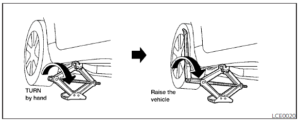
Always refer to the illustration for the correct placement and jack-up points for your specific vehicle model and jack type. Carefully read the caution label attached to the jack body and the following instructions. If a flat tire occurs on the front axle of an AWD vehicle, the spare tire must be applied to the rear axle of the vehicle.
- Loosen each wheel nut one or two turns by turning counterclockwise with the wheel nut wrench. Do not remove the wheel nuts until the tire is off the ground.
- Jack up the rear axle of the vehicle. To lift the vehicle, securely hold the jack lever and rod with both hands. Carefully raise the vehicle until the tire clears the ground. Remove the wheel nuts, and then remove the tire and set it aside.
- Apply the spare tire to the rear axle of the vehicle, replace the wheel nuts, and tighten.
- Lower the jack and further tighten the wheel nuts to the recommended torque, see “Installing the spare tire”. Jack up the front axle of the vehicle and remove the damaged wheel.
- Lower the jack and further tighten the wheel nuts to the recommended torque, see “Installing the spare tire”. Jack up the front axle of the vehicle and remove the damaged wheel.
- Apply the wheel that was removed from the rear axle to the front axle of the vehicle, replace the wheel nuts, and tighten.

Installing the spare tire
WARNING
For AWD vehicles – the TEMPORARY USE ONLY spare tire must be installed to the rear wheels only. If a front tire is punctured, install the original rear tire onto the front wheel, then install the TEMPO-RARY USE ONLY spare tire on the rear. Failure to do so could cause overheating to the AWD system The spare tire is designed for emergency use.
- Clean any mud or dirt from the surface between the wheel and the hub.
- Carefully put the spare tire on and tighten the wheel nuts finger tight.
- With the wheel nut wrench, tighten the wheel nuts alternately and evenly in the sequence illustrated (OA, OB, OC, OD, OE ) until they are tight.
- Lower the vehicle slowly until the tire touches the ground. Then, with the wheel nut wrench, tighten the wheel nuts securely in the sequence illustrated (OA, OB, OC, OD, OE ). Lower the vehicle completely.
WARNING- Incorrect wheel nuts or improperly tightened wheel nuts can cause the wheel to become loose or come off. This could cause an accident. Do not use oil or grease on the wheel studs or nuts. This could cause the nuts to become loose.
- Retighten the wheel nuts when the vehicle has been driven for 600 miles (1,000 km) (also in cases of a flat tire, etc.).
- As soon as possible, tighten the wheel nuts to the specified torque with a torque wrench.
Wheel nut tightening torque:
83 ft-lb (113 N·m)
The wheel nuts must be kept tightened to specification at all times. It is recommended that wheel nuts be tightened to specifications at each lubrication interval.
Adjust tire pressure to the COLD pressure.
COLD pressure: After the vehicle has been parked for 3 hours or more or driven less than 1 mile (1.6 km).
COLD tire pressures are shown on the Tire Load and Information label affixed to the driver-side center pillar.
After adjusting tire pressure to the COLD tire pressure, the display (if so equipped) of the tire pressure information may show higher pressure than the COLD tire pressure after the vehicle has been driven more than 1 mile (1.6 km). This is because the tire pressure increases as the tire temperature rises. This does not indicate a system malfunction.
- Securely store the flat tire in the tire well and jacking equipment in the vehicle.
NOTE:
Remove the center wheel cap before storing the flat tire. - Place the spare tire cover and the trunk floor carpeting over the damaged tire.
- Close the trunk.
WARNING
Always make sure that the spare tire and jacking equipment are properly secured after use. Such items can become dangerous projectiles in an accident or sudden stop. The spare tire is designed for emergency use.
JUMP STARTING
To start your engine with a booster battery, the instructions and precautions below must be followed.
WARNING
- If done incorrectly, jump starting can lead to a battery explosion, resulting in severe injury or death. It could also damage your vehicle.
- Explosive hydrogen gas is always present in the vicinity of the battery. Keep all sparks and flames away from the battery.
- Do not allow battery fluid to come into contact with eyes, skin, clothing or painted surfaces. Battery fluid is a corrosive sulfuric acid solution which can cause severe burns. If the fluid should come into contact with anything, immediately flush the contacted area with water.
- Keep the battery out of the reach of children.
- The booster battery must be rated at 12 volts. Use of an improperly rated battery can damage your vehicle.
- Whenever working on or near a battery, always wear suitable eye protectors (for example, goggles or industrial safety spectacles) and remove rings, metal bands, or any other jewelry. Do not lean over the battery when jump-starting.
- Do not attempt to jump-start a frozen battery. It could explode and cause serious injury.
- Your vehicle has an automatic engine cooling fan. It could come on at any time. Keep hands and other objects away from it.

WARNING
Always follow the instructions below. Failure to do so could result in damage to the charging system and cause personal injury.
- If the booster battery is in another vehicle, position the two vehicles to bring their batteries near each other.
- Do not allow the two vehicles to touch.
- Apply the parking brake. Move the shift lever to P (Park). Switch off all unnecessary electrical systems (lights, heater, air conditioner, etc.).
- Place the ignition switch in the LOCK position.
- Connect the jumper cables in the sequence illustrated (OA, OB, OC, OD ).
CAUTION
- Always connect positive (+) to positive (+) and negative (−) to body ground (for example, strut mounting bolt, engine lift bracket, etc.) — not to the battery.
- Make sure the jumper cables do not touch moving parts in the engine compartment and that the cable clamps do not contact any other metal.
- Start the engine of the booster vehicle and let it run for a few minutes.
- Keep the engine speed of the booster vehicle at about 2,000 rpm and start the engine of the vehicle being jump started.
CAUTION
Do not keep the starter motor engaged for more than 10 seconds. If the engine does not start right away, place the ignition switch in the OFF position and wait 3 to 4 seconds before trying again. - After starting the engine, carefully disconnect the negative cable and then the positive cable.
PUSH STARTING
CAUTION
Do not push start this vehicle. The three-way catalyst may be damaged. Continuously Variable Transmission (CVT) models cannot be push-started or tow-started. Attempting to do so may cause transmission damage.
IF YOUR VEHICLE OVERHEATS
If your vehicle is overheating (indicated by an extremely high-temperature gauge reading), or if you feel a lack of engine power, detect abnormal noise, etc. take the following steps.
WARNING
Do not continue to drive if your vehicle overheats. Doing so could cause engine damage or a vehicle fire. To avoid the danger of being scalded, never remove the radiator or coolant reservoir cap while the engine is still hot. When the radiator or coolant reservoir cap is removed, pressurized hot water will spurt out, possibly causing serious injury. Do not open the hood if steam is coming out.
- Move the vehicle safely off the road, apply the parking brake, and move the shift lever to P (Park).
Do not stop the engine. - Turn off the air conditioner. Open all the windows, move the heater or air conditioner temperature control to maximum hot and fan control to high speed.
- Get out of the vehicle. Look and listen for steam or coolant escaping from the radiator before opening the hood. (If steam or coolant is escaping, turn off the engine.) Do not open the hood further until no steam or coolant can be seen.
- Open the engine hood.
WARNING
If steam or water is coming from the engine, stand clear to prevent getting burned. - Visually check drive belts for damage or looseness. Also, check if the cooling fan is running. The radiator hoses and radiator should not leak water. If the coolant is leaking, the water pump belt is missing or loose, or the cooling fan does not run, stop the engine.
WARNING
Be careful not to allow your hands, hair, jewelry, or clothing to come into contact with, or get caught in, engine belts or the engine cooling fan. The engine cooling fan can start at any time. - After the engine cools down, check the coolant level in the engine coolant reservoir tank with the engine running. Add coolant to the engine coolant reservoir tank if necessary. It is recommended that you visit a NISSAN dealer for this service.
TOWING YOUR VEHICLE
When towing your vehicle, all State (Provincial in Canada) and local regulations for towing must be followed. Incorrect towing equipment could damage your vehicle. Towing instructions are available from a NISSAN dealer. Local service operators are generally familiar with the applicable laws and procedures for towing. To assure proper towing and to prevent accidental damage to your vehicle, NISSAN recommends having a service operator tow your vehicle. It is advisable to have the service operator carefully read the following precautions:
WARNING
- Never ride in a vehicle that is being towed.
- Never get under your vehicle after it has been lifted by a tow truck.
CAUTION
When towing, make sure that the transmission, axles, steering system, and powertrain are in working condition. If any of these conditions apply, dollies or a flatbed tow truck must be used. Always attach safety chains before towing.
TOWING RECOMMENDED BY NISSAN
NISSAN recommends towing your vehicle based on the type of drivetrain. For additional information, refer to the diagrams in this section to ensure that your vehicle is properly towed.
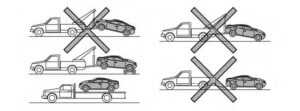
All-wheel drive (AWD) models with Continuously Variable
Transmission (CVT) NISSAN recommends that towing dollies be used when towing your vehicle or place the vehicle on a flatbed truck as illustrated.
CAUTION
Never tow All-Wheel Drive (AWD) models equipped with a Continuously Variable Transmission (CVT) with any of the wheels on the ground as this may cause serious and expensive damage to the transfer case and transmission.
- Do not use the vehicle tie-downs to tow or free a stuck vehicle.
- Only use devices specifically designed for vehicle recovery and follow the manufacturer’s instructions.
- Always pull the recovery device straight out from the front of the vehicle. Never pull at an angle.
- Route recovery devices so they do not touch any part of the vehicle except the attachment point.
- If your vehicle is stuck in sand, snow, mud, etc., use a tow strap or other device designed specifically for vehicle recovery. Always follow the manufacturer’s instructions for the recovery device.
Rocking a stuck vehicle
WARNING
- Stand clear of a stuck vehicle.
- Do not spin your tires at high speed. This could cause them to explode and result in serious injury. Parts of your vehicle could also overheat and be damaged.
If your vehicle is stuck in sand, snow, mud, etc., use the following procedure:
- Turn off the Vehicle Dynamic Control (VDC) system.
- Make sure the area in front and behind the vehicle is clear of obstructions.
- Turn the steering wheel right and left to clear an area around the front tires.
- Slowly rock the vehicle forward and backward.
- Shift back and forth between R (Reverse) and D (Drive).
- Apply the accelerator as little as possible to maintain the rocking motion.
- Release the accelerator pedal before shifting between R (Reverse) and D (Drive).
- Do not spin the tires above 35 mph (55 km/h).
- If the vehicle cannot be freed after a few tries, contact a professional towing service to remove the vehicle.
FAQ
The Hazard Flasher Switch is a control in the Altima that activates the hazard lights, also known as the four-way flashers or emergency flashers.
The Hazard Flasher Switch is typically located on the dashboard or the steering column for easy access.
To activate the hazard lights, simply push the Hazard Flasher Switch. Push it again to turn them off.
Hazard lights are typically used to indicate that your vehicle is temporarily obstructing traffic, such as when pulled over on the side of the road due to an emergency or breakdown.
The use of hazard lights is regulated by traffic laws that vary by jurisdiction. In some places, it is only permitted when the vehicle is stationary or during specific emergency situations.
The use of hazard lights while driving is often discouraged and may be illegal in some areas, as it can be confusing to other drivers and hinder communication of your intentions.
In some cases, using hazard lights while driving may be permitted during extreme weather conditions, such as heavy rain or fog, to increase visibility. Check local laws for guidelines.
The Hazard Flasher Switch is primarily designed for activating hazard lights and does not typically control other functions.
Replacing or repairing the Hazard Flasher Switch should be done by a qualified technician to ensure proper functionality and safety.
If the hazard lights are not working, it’s advisable to have the vehicle inspected by a Nissan dealership or a certified mechanic to diagnose and address the issue.
There may be indicator lights on the instrument panel that illuminate when the hazard lights are active, providing a visual confirmation.
The hazard lights typically activate all the lights simultaneously, including both front and rear lights.
The hazard lights are often designed to stay on even if the ignition is turned off. You need to manually deactivate them using the Hazard Flasher Switch.
Hazard light flashing patterns are typically standardized and cannot be customized in most vehicles, including the Altima.
Activating the hazard lights typically does not affect other vehicle systems or components, as they are designed to operate independently.
Useful Link
View Full User Guide: Nissan ALTIMA 2023 User Guide
Download Manuals: https://www.nissanusa.com/owners/ownership/manuals-guides.html
2023 Nissan Altima Specs, Price, Features and Mileage (Brochure)


